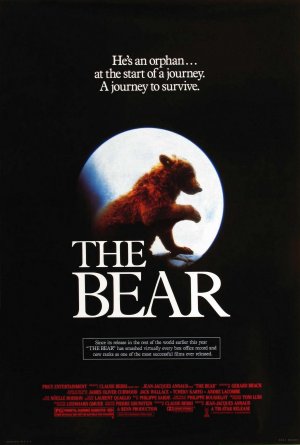- The Bear (1988 film)
Infobox Film
name = The Bear (Ours, L')

image_size =
caption = American film poster
director =Jean-Jacques Annaud
producer =Claude Berri
writer = Novel:James Oliver Curwood
Screenplay:Gérard Brach
starring =Bart the Bear Douce Tchéky Karyo Andre Lacombe Jack Wallace
music =Philippe Sarde
cinematography = Philippe Rousselot
editing = Noëlle Boisson
distributor =TriStar Pictures
released = flagicon|FranceOctober 19 1988
flagicon|USAOctober 25 , 1989
runtime = 94 min.
country =France
language = English
gross = $31,753,898 (USA domestic)
amg_id = 1:4445
imdb_id = 0095800:"For The Raymond Briggs adaptation, see
The Bear (1999 film) ""The Bear", (1988) known as "L'Ours" in its original release, is a
feature film directed byJean-Jacques Annaud . The screenplay byGérard Brach was adapted from the novel "The Grizzly King " byJames Oliver Curwood .Set in late 19th century
British Columbia ,Canada , the film tells the story of an orphaned bear cub befriended and protected by an adult male grizzly as hunters pursue them through the wilds.Though the film did not enjoy overwhelming commercial success with its North American release, it was acclaimed in France, [L'Ours is the 22th in the French all-time box-office with an audience of 9 millions [http://www.allocine.fr/film/meilleurs_gen_filtre=bofrance&critique=&annee=&tri=touslestemps&page=2.html] ] and was nominated for and won numerous international film awards.
Plot and cast
In the mountainous wilds of
British Columbia , agrizzly bear cub (Douce) suffers the death of his mother from a rockslide. Soon the young cub meets a large male grizzly (Bart the Bear ) attempting to soothe a bullet wound inflicted by a pair of hunters (Jack Wallace andTcheky Karyo ). A friendship forms between the two bears.The two hunters are joined by another hunter (
Andre Lacombe ) and a pack of hunting dogs. The bears are chased over a ridge with the dogs in pursuit. The cub hides and the grizzly lures the dogs away, killing some of them. The hunters find the cub, take him to their camp, and tease and torment him. They leave to pursue the larger bear.The hunters separate and the younger one is suddenly cornered, without his gun, by the grizzly. Faced with the bear's menacing roars and snarls, the hunter cowers in fear and whimpers in the face of certain death. The grizzly, seemingly affected by the hunter's distress, turns and leaves. The hunter is met by his partner and the two leave the wilds.
The bear cub is confronted by a
cougar and tries to defend himself. As the cougar nears, the cub turns to find his older friend and protector. They embrace. Winter approaches and the two bears enter a cave. Settling down, the cub experiences his first peaceful sleep since his mother's death.Production notes
The film was shot in the
Dolomites .Commentary
The film opens with a quote from
The Grizzly King : "The greatest thrill is not to kill but to let live." The plot focuses on the idea of compassion for life and nature. At the end of the story we see that the younger of the two hunters has become wiser. He has survived because of the mercy afforded him by the grizzly. When found unarmed and helpless by the grizzly male, the younger hunter was at the grizzly's mercy. The grizzly left the young hunter alive, but could easily have killed him. Recovering from his shock, the young hunter first thought to kill the grizzly, but then gave thought to a deeper inspiration and allowed the grizzly to live, affording the bear the same mercy that was afforded him. We then learn that the older of the two hunters shares the thoughts of the younger hunter. The older hunter says near the end: "Everyone has a secret place, and by God that is how it should be." Ultimately the film shares its philosophical sentiment with that of the book on which it is based, that of aBiocentric orDeep Ecology .Reception
Janet Maslin in the "New York Times " of October 25, 1989, wrote: "The Bear"...is a remarkable achievement only on its own terms, which happen to be extremely limited and peculiar...its true emphasis is not on wildlife. Instead, it grafts the thoughts and dreams of more commonplace beings onto bear-shaped stand-ins." Miss Maslin also wrote, "A mating scene between bears interrupts what is otherwise wholly childworthy entertainment." [ [http://movies.nytimes.com/movie/review?res=950DE3DC1339F936A15753C1A96F948260New York Times Review] . Retrieved 22 September 2008.]The film was a critical success and retains a 100% Fresh rating at Rotten Tomatoes.com. [ [http://www.rottentomatoes.com/m/bear/ "The Bear" at Rotten Tomatoes] Rotten Tomatoes]
Awards and nominations
Won:
* 1988: National Academy of Cinema, France, Academy Award (Jean-Jacques Annaud)
* 1989:César , Best Director (Jean-Jacques Annaud )
* 1990:Genesis Award , Feature Film (Foreign)
* 1990: Guild of German Art House Cinemas Film Award, Silver Foreign Film (Ausländischer Film) (Jean-Jacques Annaud)Nominated:
* 1990: Academy Award, Best Film Editing (Noëlle Boisson )
* 1990: American Society of Cinematographers Award, Outstanding Achievement in Cinematography in Theatrical Releases (Philippe Rousselot )
* 1990:BAFTA Film Award, Best Cinematography (Philippe Rousselot)
* 1990:Young Artist Award , Best Family Motion Picture - Adventure or Cartoon
* César - Best Cinematography (Philippe Rousselot)
* César - Best Film (Jean-Jacques Annaud)
* César - Best Poster (Claude Millet, Christian Blondel, Denise Millet)
* César - Best Sound (Bernard Leroux, Claude Villand, Laurent Quaglio)References
Wikimedia Foundation. 2010.
